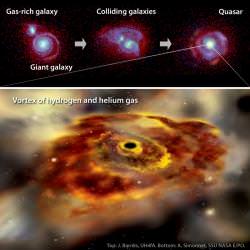Some galaxies are relatively quiet, while others blaze with enough radiation that we can see them clear across the Universe. Astronomers now understand that these quasars are formed when the supermassive black holes at the heart of galaxies are actively feeding on material. But where does this material come from?
What sets quasars off?
New research led by two astronomers from the University of Hawaii, Hai Fu and Alan Stockton, seems to give the answer. When you bring a gas-poor galaxy together with a gas-rich galaxy, the cosmic collision feeds fresh hydrogen and helium directly into the maw of the supermassive black hole. Material backs up, then heats up, and then it blazes across the electromagnetic spectrum. Explosions can detonate in the surrounding accretion disk, hurtling back outward again.
Astronomers have suspected this mechanism was happening, but they weren’t sure where this fuel supply of gas was coming from. Using the Hubble Space Telescope and telescopes on Mauna Kea, Hawaii, the researchers analyzed the chemical constituents of material falling into a distant quasar.
They found that this gas was almost pure hydrogen and helium – mostly untouched since the Big Bang. This is much different from the stars and other material in the surrounding giant galaxy which are polluted with heavier elements like carbon and oxygen. The black hole is getting a fresh supply of uncontaminated material.
This difference means that the infalling gas is coming from an external source, probably from another galaxy which is currently in the process of merging. This material comes in, and it also goes out. The tremendous forces and energies involved expel material away from the black hole, helping it travel thousands of light-years away.
Original Source:Institute for Astronomy

